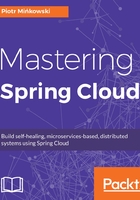
Netflix OSS
On reading the first two chapters, you have probably noticed the appearance of many keywords related to microservice architecture. For some of you, it might be a new term, for others, it is well known. But so far, one important word to the microservices community has not been mentioned yet. It is definitely known by most of you, this word is Netflix. Well, I also like their TV shows and other productions, but for developers, they are famous for another reason. This reason is microservices. Netflix is one of the earliest pioneers of migration from a traditional development model where we created monolithic applications for a cloud-native microservices development approach. This company shares their expertise with the community by pushing a great part of the source code into the public repository, speaking in conference presentations, and publishing blog posts. Netflix has been so successful with its architecture concept that they became a role model for other large organizations and their IT architects such as Adrian Cockcroft are now prominent evangelists for microservices. In turn, many open source frameworks based their libraries on the solutions available under the code shared by Netflix. It is no different for Spring Cloud, which provides integrations with the most popular Netflix OSS features such as Eureka, Hystrix, Ribbon, or Zuul.
By the way, I don't know if you have been following Netflix, but they shed some light on the reasons why they decided to open source much of their code. I think it is worth quoting because that partly explains the success and unwaning popularity of their solutions in the IT world: